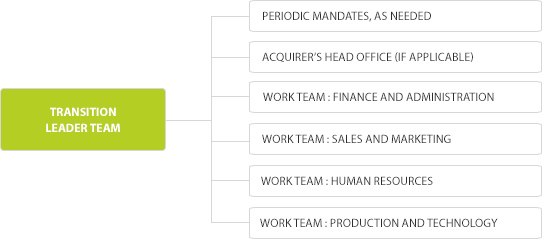Our publications / A smooth post-acquisition integration process
Congratulations! You have just acquired your main competitor: what a brilliant move! You are now a leader in your market. The only problem is that your financial structure is now less solid. Plus, you need to integrate your competitor into your company quickly and efficiently. What should you do? The following is an overview of a proven integration process.
The rationale behind the acquisition (the “business case”)
To efficiently begin the integration process, it is imperative that the rationale for the acquisition be properly explained to all your employees.
Mechanisms and structures to be implemented
Now that the reasons for the acquisition have been explained to everyone, an integration structure must be set up.
I am proposing the following:

Transition leader team:
The methodology described in Graph 1 is centred on a transition leader team. This team should include the presidents and senior managements from both companies. It may be a good idea to include an outside consultant. The team has a key role. Basically, this team is where difficult decisions are made and where certain internal discussions are decided, and it has final say.
The Transition Leader Team defines the responsibilities of each work team along with the timetable. It must also choose each work team’s manager. Next, the work team members are chosen by the manager and approved by the Leader Team. The Transition Leader Team has other responsibilities, such as:
- Drawing up the transition policies and reviewing the integration options ;
- Providing the various work teams with appropriate instructions ;
- Recommending organizational changes needed for smooth integration ;
- Ensuring that key personnel is retained ;
- Revising the organizational charts proposed by the work groups.
Work teams:
- Which products will be favoured? Should the combined range of products/services be kept?
- Will there be any inconsistencies in pricing?
- Are there choices to be made among the distribution networks?
- Should the human resources policies be standardized?
- How can production be integrated?
- Do technological choices need to be made?
- How can the company be integrated with respect to accounting systems?
Periodic mandates:
Acquirer’s head office:
The acquirer is sometimes a division. In these cases, the head office may choose to put a representative on the Transition Leader Team (somewhat rare) or require regular reports on the progress of the integration work. In any event, the Transition Leader Team must take into account the head office’s vision, prerogatives and limitations in its integration approach.
Preliminary action plan
To ensure a quick startup, a preliminary action plan by work team is required.
Besides speeding up the process, the action plan puts the emphasis in the right places from the outset. It is sometimes difficult to rectify a poor start, which is often very costly.
To conclude, smooth integration is achieved by dealing directly with all the key issues confronting the company through an approach that allows for quick corrections and ongoing feedback between senior management and the company’s middle managers. Best of luck with your acquisition!
